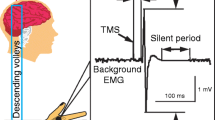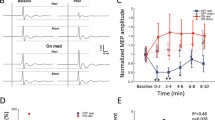Abstract
Reduced short-interval intracortical inhibition (SICI) is reported in Parkinson’s disease (PD) and is considered to reflect abnormal GABAergic inhibitory system of the primary motor cortex in PD. We have recently shown, however, that SICI using anterior-posterior directed currents in the brain was normal in focal dystonia even though that using posterior-anterior currents was abnormal, indicating that the GABAergic system of the primary motor cortex is largely normal in dystonia. Here, we studied SICI in PD to clarify whether the GABAergic system is completely impaired in PD. We used paired-pulse transcranial magnetic stimulation to study SICI at interstimulus intervals of 3 and 4 ms with anterior-posterior or posterior-anterior directed currents in eight PD patients and ten healthy volunteers. The amount of SICI with posterior-anterior directed currents was reduced in PD patients compared with healthy volunteers; in contrast, SICI studied with anterior-posterior directed currents was normal in PD patients. These observations may be due to the difference in I-wave composition generated by the two directed currents and/or the difference in responsible inhibitory interneurons for the inhibition between the two current directions. We suggest that some or a part of inhibitory interneurons are not involved in PD. This discrepancy between SICI using posterior-anterior and anterior-posterior directed currents experiments may provide additional information about the circuits of the motor cortex.

Similar content being viewed by others
References
Bares M, Kanovský P, Klajblová H et al (2003) Intracortical inhibition and facilitation are impaired in patients with early Parkinson’s disease: a paired TMS study. Eur J Neurol 10(4):385–389
Berardelli A, Rona S, Inghilleri M, Manfredi M (1996) Cortical inhibition in Parkinson’s disease. A study with paired magnetic stimulation. Brain 19:71–77
Chu J, Wagle-Shukla A, Gunraj C et al (2009) Impaired presynaptic inhibition in the motor cortex in Parkinson disease. Neurology 72(9):842–849
Daniel SE, Lees AJ (1993) Parkinson’s Disease Society Brain Bank, London: overview and research. J Neural Transm Suppl 39:165–172
Di Lazzaro V, Oliviero A, Pilato F et al (2004) Comparison of descending volleys evoked by transcranial and epidural motor cortex stimulation in a conscious patient with bulbar pain. Clin Neurophysiol 115:834–838
Fahn S, Elton RL (1987) Members of the UPDRS development committee unified Parkinson rating scale. In: Fahn S, Marsden CD, Calne DB, Goldstein M (eds) Recent developments in Parkinson’s disease. Macmillan Publishing, New York, pp 153–163
Fisher RJ, Nakamura Y, Bestmann S, Rothwell JC, Bostock H (2002) Two phases of intracortical inhibition revealed by transcranial magnetic threshold tracking. Exp Brain Res 143(2):240–248
Hanajima R, Ugawa Y, Terao Y et al (1996) Ipsilateral corticocortical inhibition of the motor cortex in various neurological disorders. J Neurol Sci 140:109–116
Hanajima R, Ugawa Y, Terao Y et al (1998) Paired-pulse magnetic stimulation of the human motor cortex: differences among I waves. J Physiol 509:607–618
Hanajima R, Furubayashi T, Iwata NK et al (2003) Further evidence to support different mechanisms underlying intracortical inhibition of the motor cortex. Exp Brain Res 151(4):427–434
Hanajima R, Wang R, Nakatani-Enomoto S et al (2007) Comparison of different methods for estimating motor threshold with transcranial magnetic stimulation. Clin Neurophysiol 118(9):2120–2122
Hanajima R, Okabe S, Terao Y et al (2008) Difference in intracortical inhibition of the motor cortex between cortical myoclonus and focal hand dystonia. Clin Neurophysiol 119:1400–1407
Kujirai T, Caramia MD, Rothwell JC et al (1993) Corticocortical inhibition in human motor cortex. J Physiol 471:501–519
MacKinnon CD, Gilley EA, Weis-McNulty A, Simuni T (2005) Pathways mediating abnormal intracortical inhibition in Parkinson’s disease. Ann Neurol 58:516–524
Nakamura H, Kitagawa H, Kawaguchi Y, Tsuji H (1997) Intracortical facilitation and inhibition after transcranial magnetic stimulation in conscious humans. J Physiol 498:817–823
Ni Z, Charab S, Gunraj C, Nelson AJ, Udupa K, Yeh IJ, Chen R (2011) Transcranial magnetic stimulation in different current directions activates separate cortical circuits. J Neurophysiol 105:749–756
Ridding MC, Inzelberg R, Rothwell JC (1995a) Changes in excitability of motor cortical circuitry in patients with Parkinson’s disease. Ann Neurol 37:181–188
Ridding MC, Taylor JL, Rothwell JC (1995b) The effect of voluntary contraction on cortico-cortical inhibition in human motor cortex. J Physiol 487:541–548
Sakai K, Ugawa Y, Terao Y, Hanajima R, Furubayashi T, Kanazawa I (1997) Preferential activation of different I waves by transcranial magnetic stimulation with a figure-of-eight-shaped coil. Exp Brain Res 113:24–32
Strafella AP, Valzania F, Nassetti SA et al (2000) Effects of chronic levodopa and pergolide treatment on cortical excitability in patients with Parkinson’s disease: a transcranial magnetic stimulation study. Clin Neurophysiol 111(7):1198–1202
Valls-Solé J, Pascual-Leone A, Brasil-Neto JP et al (1994) Abnormal facilitation of the response to transcranial magnetic stimulation in patients with Parkinson’s disease. Neurology 44:735–741
Ziemann U, Lonnecker S, Steinhoff BJ, Paulus W (1996) Effects of antiepileptic drugs on motor cortex excitability in humans: a transcranial magnetic stimulation study. Ann Neurol 40:367–378
Acknowledgments
This work was supported in part by Research Project Grant-in-aid for Scientific Research No. 20591019 (RH) and No. 22390181 (YU) from the Ministry of Education, Culture, Sports, Science, and Technology of Japan, and by the Research Committee on rTMS Treatment of Parkinson’s Disease from the Ministry of Health and Welfare of Japan.
Conflict of interest
All authors have no disclosure or conflict interest.
Author information
Authors and Affiliations
Corresponding author
Rights and permissions
About this article
Cite this article
Hanajima, R., Terao, Y., Shirota, Y. et al. Short-interval intracortical inhibition in Parkinson’s disease using anterior-posterior directed currents. Exp Brain Res 214, 317–321 (2011). https://doi.org/10.1007/s00221-011-2829-2
Received:
Accepted:
Published:
Issue Date:
DOI: https://doi.org/10.1007/s00221-011-2829-2




